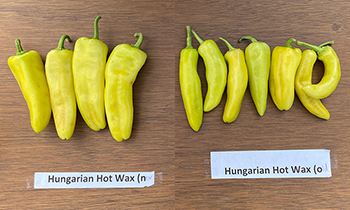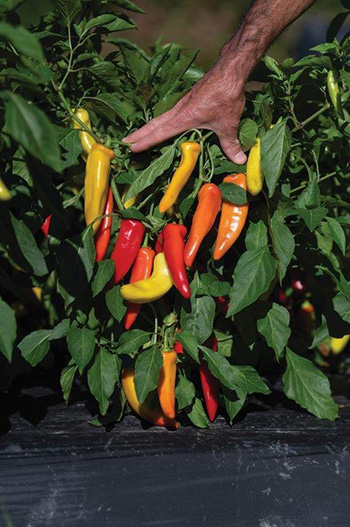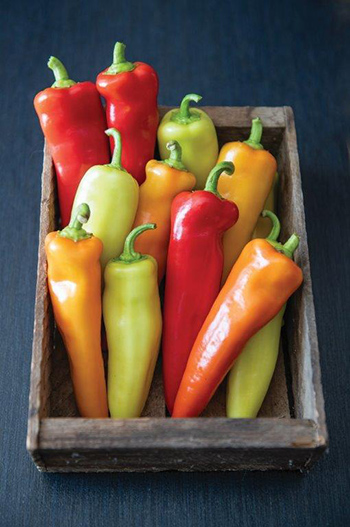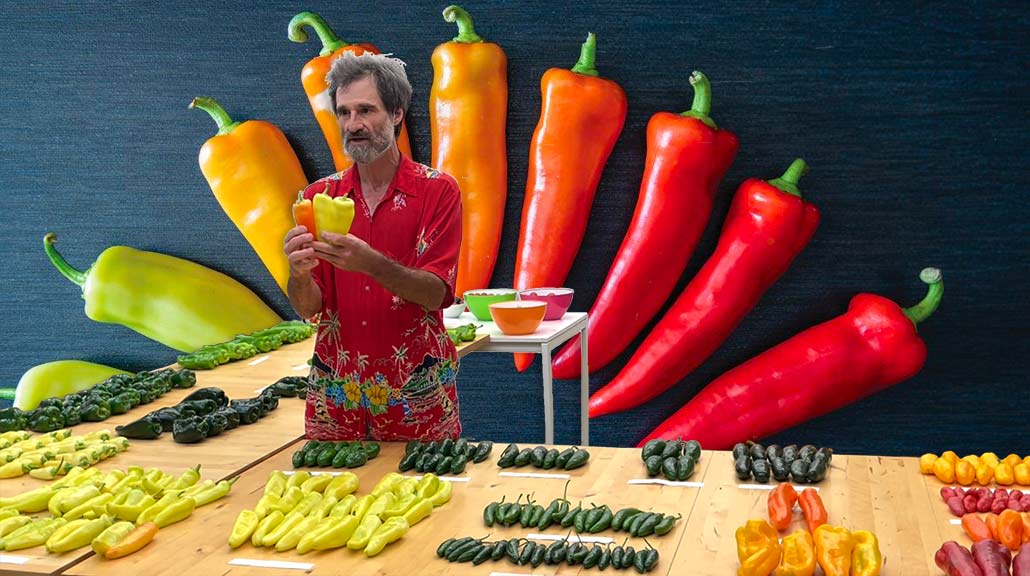- Johnny's Research Farm | Breeding, Trialing, Selection & Quality Assurance
- Johnny’s OP Stewardship Project: Restoration of ‘Hungarian Hot Wax’ Pepper
- Open-Pollinated Revival Project: 3 Improved OP Heirloom & Heritage Tomatoes
- A Brief History of Tool Development at Johnny's | Planting the Seed of a Small-Scale Farming Revolution
- Classical Plant Breeding at Johnny's | by Rob Johnston, Jr, Plant Breeder (Retired) & Founder of Johnny's Selected Seeds
- 5 JSS-Bred Varieties Introduced by Rob Johnston, Jr., Plant Breeder & Founder (Retired), Johnny's Selected Seeds
- 3 for 2020: New Johnny-Bred Stories by Rob Johnston, Jr. | ‘Starry Night,’ ‘Citrine’ & ‘Pipsqueak’
- Classical Plant Breeding at Johnny's Selected Seeds | Infographic
- About Johnny's Variety Trialing Program
- Seed Variety Trialing – Why Try Something New?
- Seed Variety Trialing at Johnny's Selected Seeds | Infographic
- How to Conduct a Scale-Appropriate Trial on Your Own Farm
- All-America Selections Award-Winning Varieties Bred by Johnny's | Spec Sheet
- Varieties Bred by Johnny's | 4-pp Brochure
- About Johnny's | PDF
- Johnny's Announces 'Rhubarb Supreme' | New Bolt-Resistant Strain of a Favorite, Open-Pollinated Swiss Chard | Press Release
- Johnny's Corno di Toro Peppers Rule | Press Release
- Pea Selection at Johnny's | The Story of 'Sugar Ann' Snap Pea
- The Johnny's Advantage | PDF
- Video: Classical Plant Breeding at Johnny's
- Video: 'Cherry Bomb' | JSS-Bred Organic Cherry x Grape Tomato from Johnny's
- Video: Johnny's Trialing Program
- Video: Hand-Pollinating Peppers at Our Research Farm | Classical Plant Breeding at Johnny's Selected Seeds
- Video: 'Clementine' | The Tangerine-Colored, Organic Cocktail Tomato from Johnny's Breeding Team
- Johnny’s Selected Seeds Observes 50th Anniversary | Press Release
- Johnny's Welcomes Kevin L Cook, PhD as VP of R&D | Press Release
- Video: Restoration of OP 'Hungarian Hot Wax' Pepper | Exclusively from Johnny's Selected Seeds
- Farm Tours of Johnny's Research & Trialing Farm
Johnny's Open-Pollinated Stewardship Project: Restoration of 'Hungarian Hot Wax' Pepper
Plant Breeding Journey: Resurrecting a Reliably Productive Cool-Weather Pepper
For many years, Johnny's plant breeder, Dr. John Navazio and pepper product manager, Steve Bellavia had been noticing degradation in the plant habit, fruit flavor, and fruit shape of many commercial strains of 'Hungarian Hot Wax' pepper. This variety of pepper is a longtime favorite of many growers in cooler zones because it matures very early, even in chilly, wet weather.
In climates similar to those of the maritime region of the Pacific Northwest, notes Navazio, where he lived and worked for over 20 years as an organic grower and plant breeder, "Heat-loving crops like peppers need to be transplanted out later, because they fail to thrive when it's still 48–52°F (9–11°C) for 18 out of 24 hours a day. Even though the average last frost date may be in early April, your pepper seedlings might have the best chance if you put the transplants in the ground in late May or the first week of June, when it's warm enough that they can actually grow, not just sit there. Then you enter into what can be, what some Pacific Northwesterners affectionately call Juneuary, when it can be cloudy and drizzly up until the 4th of July, after which, suddenly, you are in one of the driest places in the whole continent. Finally, it gets warmer and the peppers grow. Historically, however, even on the warmest days of many summers in British Columbia, the mercury doesn't climb much above 72°F (22°C). What this means is that as a grower, you've got to have a pepper variety that works well in the early, subpar temps of early Juneuary, that can then grow and produce. Remember, if days as warm as 78°F (26°C) there, businesses shutter with a sign on the door: 'CLOSED: Stayed home today — too hot!' "
While it is not uncommon for seed companies to undertake maintenance work to "clean up" their stocks (even of older OP varieties like 'Hungarian Hot Wax') to make sure the variety grows true to type,1 John had heard feedback from a number of growers as to the lackluster results of these strains. "Many growers had these challenges," relates John, "where 'Hungarian Hot Wax' had been a true winner, even over most hybrid peppers. It was still so popular for all our customers in that area, a truly important money-maker for fresh-market hot peppers." He then adds, "Not only was it successful for all of the above," but its popularity may be at least partly attributable to its being a "nice mild hot pepper that isn't too hot!"
True to type refers to a variety strain whose seed will grow the same type of plant as the original (parent) plant. With care to prevent cross-pollination with strains that do not grow true to type, open-pollinated plants will almost always grow true to seed.
Thus it was from disappointment that an initiative was born on the part of Johnny's R&D department: to develop our own strain of 'Hungarian Hot Wax', with a 3-pronged goal:
- restore the best qualities of this long-cherished open-pollinated (OP) variety;
- maintain a foundation stock of the improved strain; and
- offer growers a dependably improved strain, once and for all.
Our mission is helping families, friends, and communities to feed one another by providing superior seeds, tools, information, and service.
The stewardship component of the project aligns well with our mission,2 in affording us the opportunity to genuinely "take care of" a productive, great-tasting, OP pepper variety that helps growers make a living while feeding their families, friends, and communities.
Selective Breeding Timeline
While it may seem at first blush to be just another clean-up project, the process was an involved one that began with several consecutive years of selective breeding.3
In plants, selective breeding means choosing parent plants with particular characteristics to breed together and produce offspring plants with more desirable characteristics.
John explains, "Most seed companies that try to 'clean up' an existing cross-pollinated variety perform just one generation of 'intense' mass selection and call it good, which usually doesn't result in much improvement at all. True plant breeding and plant breeding skills are required to rescue a formerly high-quality variety that is genetically suffering due to mismanagement or benign neglect. It especially requires real plant breeding expertise in a crop like pepper that frequently manifests a degree of cross-pollination. (It is easier in a predominantly self-pollinated species like beans, for example, where fewer than 1% of beans will cross-pollinate.)"
YEAR 1 • 2015

— Steve Bellavia
In 2015, John and Steve obtained 5 strains of 'Hungarian Hot Wax' (HHW) seed from differing sources. That first year the 5 strains were seeded indoors, then transplanted and grown in separate plots in the same field at Johnny's Research Farm in Albion, Maine.
John and Steve closely evaluated the overall performance of each plant of each the 5 strains in the 5 plots.
"We found that the lots were of varying levels of quality, some being mediocre and some being downright odious," reports Steve. "The commercially available strains generally had poor floppy plants, which resulted in more rot and curved fruits." Whereas a certain percentage of curved fruits is normal and acceptable in peppers, a high degree is not. A high percentage of strong fruit curvature might be due to the fruit lying directly on the ground as it matures, which in turn can be a direct result of what is known as lodging — plant lingo, meaning the plants are tipping or falling over. All of Johnny's pepper trials aim to eliminate this undesirable trait.
"Also," Steve continues, "some strains had longer, cayenne-type, off-type fruits. What's more, the heat level varied quite a bit. Some plants produced fruits which were overly hot for HHW and some were not hot enough."
What were the specifics for selection?
Only sturdy, upright plants and good, true-to-type fruits in terms of size, shape, and heat level.
They decided that only 2 of the strains were above-average, good enough, or worthy of continuing with, in the breeding process. They then harvested seeds — but from only the best plants within those 2 above-average strains. Steve recaps: "From 2 of the commercial seed strains we selected the plants with the best, most upright plants and best fruit quality and heat level, and saved seeds from them."
John adds, "We started this project through evaluation of 5 different strains of HHW, and the next step was to make a strain cross with the 2 best ones, after eliminating all of the subpar plants in each of the 2 strains. That left us with just 10–14 plants from which we harvested seeds, or about a third of the total number of plants in each of the two Year-1 plots."
YEAR 2 • 2016
What does evaluating breeding test plots entail?
Are notes taken all through the growing season, and what are you noting?
We evaluate the plants periodically, at critical growth stages in the life cycle, and notes are taken throughout. We always want to see the health, vigor, and performance of the plant. We may even evaluate them at as early a stage as germination in their seedling flats. We want to be sure that they have good vigor and uniformity, but also to check whether, and as soon as, disease is present, and whether one or two of the strains are more disease prone or resistant.
We always evaluate them directly after transplanting, as transplanting can deliver a make-or-break shock to seedlings. Later on, an evaluation visit to the test plot could be used to determine early lodging (bad) and early fruit set (good!). Still later visits could determine earliness and plant-leaf-per-fruit ratio (a measure that can affect fruit quality).
Are fruits collected from plants at full maturity from which the seeds are extracted — or, are the fruits collected as the plant continues to produce through the harvest window?
We do grow them to full maturity. In the earliest cycles (selective plant breeding years, in this project), fruits might be collected from the good seed lots, but often they are not, as bees may have crossed the good seed lots with the bad ones. We want to see how they mature — if one of the strains is inferior and we're trying to avoid cross-pollination, we know we're going to eliminate that bad strain. With fruit, we look to see which plants are most productive, how the fruit are shaped, how close to our ideotype4 are they, and so on.
As plant breeders, when we're doing an evaluation what we are really doing is an evaluation with the intent all along of saving seeds from the best plants. Thus, the test plot is a form of nursery. Growing nursery plots of the different 'Hungarian Hot Wax' strains, then selecting the best plants over several years, allows us to achieve the best seed for our stock.
The following year, seeds from the best plants of those 2 initially-selected strains were grown as individual rows from each mother plant that was selected. From those plants, Steve and John then "selected hard" for the smoothest, prettiest, best-tasting fruits and the most rugged, upright plants. By choosing to leave only the best plants out of the best rows, again they allowed only the best of the best to cross-pollinate. Then, they saved seeds from those plants.
John explains, "When you start a half-sibling family selection process, that's what you do. If it's a decent strain of a variety, you end up taking about a third of the plants. So we saved the seeds of 10 plants of each of the 2 strains, giving us 20 little packets of seeds for the following year.
"Because we were taking good notes to refer back to all along, we knew which strains our seeds originated from — let's say, strains #3 and #5, with the seeds in each strain being from same mother but different dads. In year 2, a new row was planted from those selected 2 packets.
"And that's the beauty of half-sibling selection — now you don't have to get hung up on the crossing — because once you get to this next level, you already have much better material because you've ultimately eliminated the 'baddies.'
"Steve and I were adamant that if we knew the plant wasn't good enough, we eliminated them early enough that we were able to get pepper fruits that had not been pollinated with the weak players.
"Then we did the next evaluation — in other words, we used half-sibling family selection to get to the subfamilies that were worthy of becoming our 'new JSS strain,' and then did a third generation of mass selection.
"Out of those 20, let's say we picked plants 1–10 from strain #3 and plants 11–20 from strain #5. We looked at those half-sibling families from the 2 different strains. We knew we were always going to see which ones were better from all those single-mother plants. Those are considered 'families,' with half-siblings (again, the progeny all have the same mum but different dads). We only found 3–5 plants that were any good from each. So in years 1 and 2, we were saving seeds from the individually best plants and planting them as mother rows the following year."
YEAR 3 • 2017
Put more simply, ideotype is a contraction of "ideal type": the breeder envisions everything they want as the destination goal for their breeding journey.
In resurrecting an open-pollinated variety such as 'Hungarian Hot Wax,' this includes everything of value noted in the original variety, but in seeking the ideal, Johnny's aims to take a great variety and make it greater.
One aspect of the ideal involves breeding within an organic farming system, which differs fundamentally from conventional agriculture by presenting complex environmental stressors. By default, selection criteria on our farm include the ability to thrive in a low-input setting, and the particular lineage of 'Hungarian Hot Wax' you receive from us possesses an extra measure of field toughness.
The third year, seeds from those rigorously selected plants were planted and grown, and the team repeated this rigorous selection process. By year 3, we were "bulking" the seed, a breeding term that means combining seeds from multiple plants into one seed lot. We were harvesting seeds from all of the plants in the most outstanding rows.
YEARS 3—5 • 2017–2019
From 2017 to 2019, Johnny's former Pepper and Tomato Breeder, Emily Haga, and our Breeding Technician, Kelsey Schrey worked together on the project, to further select for a more upright plant habit. John recalls, "I can remember being up in field 14 with Emily — it was at least year 4 — looking at the rows with her. She really had come along with us, and together we had all done a good job. By then it was obvious what was best."
YEAR 6 • 2020
In 2020, Breeding Technician Ben Brown and Pepper Breeder Kevin Cook (now Johnny's VP of R&D) took over the project to do the final selection work.
Kevin, Ben, Steve, and Pepper Trialing Technician Nate Gorlin-Crenshaw reviewed the selections in the field and chose the best ones.
YEAR 7 • 2021
Was there anything else specific about the criteria for selection at this stage?
"No," Steve declares. "The criteria were always the same, and we were always rigorous with our selections. As John is wont to say, 'When in doubt throw it out!' "
The following year (2021), Kevin, Ben, Steve, and Nate made final selections and saved seeds from them. In 2021, the seed was again "bulked."
Steve recalls, "The variety was now excellent — the plants were sturdy and upright with very little lodging and the fruits were uniform and true-to-type, with the correct heat level for 'Hungarian Hot Wax'."
YEAR 8 • 2022

Seeds from the final 2021 selections were given to our Seed Production Manager, Bonita Nicholas and Foundation Seed Technician, Sam Mudge. These seeds were used to produce a commercial seed crop at the Albion Farm in 2022.
Kudos to the farm crew, as well, under the management team of Collin Thompson and Jon Ault for doing an excellent job growing the crop, then harvesting the fruits and extracting the seeds!
YEAR 9 • 2023
We are pleased to introduce Johnny's new 'Hungarian Hot Wax' OP strain for the 2023 growing season and beyond. Features include upright plant architecture that offers ergonomic, efficient harvesting with minimal fruit damage. Field-tough plants bear harvest-ready fruits an average of several days earlier than other strains we've trialed, again because it matures even in cool, wet weather. Measuring 5½–7½" in length at maturity, the fruits are uniformly smooth, tapered, and moderately piquant in flavor. Color transitions from pale yellow to orange-red, to ultimately reach vibrant red at full maturity.

Back when John first came to Johnny's, there were farmers John knew who weren't seed growers, but flexible enough to occasionally save their own seed, and who, because 'Hungarian Hot Wax' was so valuable to them, began selecting and saving their own seed. We commend and revere the age-old practice of seed-saving, but if it's not in your bailiwick or you don't have time to jump the high hoops of plant breeding, you can still have access to all the finest qualities of this variety. We hope you'll give this strain a try and let us know what you think, whether your region experiences the cool, wet springs characteristic of the Pacific Northwest or you enjoy the warm dry conditions most favorable to peppers — in which case, it'll probably yield even better.
To this day John, Steve, and many other members of Johnny's R&D and Sales teams visit and talk with farmers, catching up on how things are growing in areas across the continent and even globally. Now in his eighth year of organic plant breeding in Maine, John remains familiar with the iffy spring conditions that can make or break a pepper crop. Thus it is well understood why this particular strain of a pepper variety with a history of outstanding performance in uncertain times is one we will steward with care.
In looking back, reflects John, "With plant breeding, sometimes you do get lucky — but yes, we had picked good material. That's the power of good plant breeding — we were diligent about only taking the best stuff — so we ended up with a strain that isn't too bad!"
We'll be here when you're ready, ringing the bell on an improved strain of a long-time favorite OP pepper, as an adaptable, field-tough producer under a wide diversity of conditions.
Learn More
To learn more about Johnny's OP Stewardship, refer to the following:


